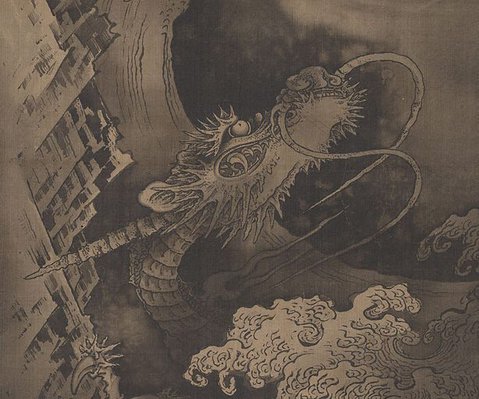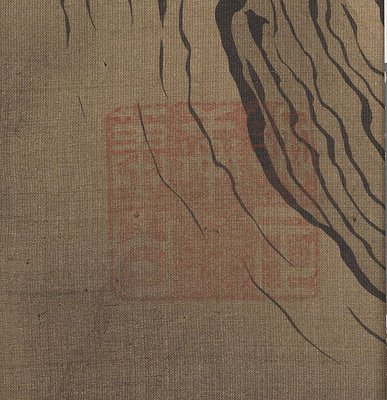


-
Details
- Place where the work was made
-
Japan
- Period
- An'ei era 1772 - 1781 → Edo (Tokugawa) period 1615 - 1868 → Japan
- Media categories
- Scroll , Painting
- Materials used
- hanging scroll; ink on silk in paulownia wood storage box
- Dimensions
- 96.5 x 33.5 cm
- Credit
- Purchased with funds donated by Warwick and Ann Johnson and the Asian Art Collection Benefactors 2007
- Location
- South Building, lower level 1, Asian Lantern galleries
- Accession number
- 205.2007
- Copyright
- Artist information
-
Soga Shōhaku
Works in the collection
- Share
-
-
About
This hanging scroll depicts a fierce dragon emerging from billowing waves. The large waves end in decorative somewhat manneristic crests that curl around the dragon’s body. Only the large head featuring bulging eyes, a long and pointed horn, long whiskers and big, sharp teeth, as well as two forelegs with spread out claws, are visible. The dragon twists its head in a dramatic curve to look upward, whereas the movement of the head is in accordance with the curves of the waves above it. The curvy lines of the waves and the dragon’s body are contrasted masterfully with the angular, sharp outlines of the rock on the left border of the hanging scroll. Applying only black ink, the artist succeeds in exploiting a range of expression, juxtaposing clear, thin lines with large areas of soft wash as well as lighter and darker ink tones. Especially the uppermost wave crest, defined skilfully by soft wash, deserves attention.
Together with Nagasawa Rosetsu (1754-1799), by whom two works are in the Gallery’s collection, and Itô Jakuchû (1716-1800), Shôhaku belongs to the “Three Eccentrics” of the Edo period. Ignoring the newly emerging artistic trends of his time, Shôhaku chose to turn back to the 15th century ink painting tradition for inspiration and established a fictive genealogy, claiming himself to be the 10th generation heir of Soga Dasoku, a monk painter associated with the Daitoku Zen temple, Kyoto. Although the basic vocabulary of his art comes from the tradition of Muromachi period ink painting, Shôhaku added a quality of personal dynamism and fantasy to his works that boldly distinguishes them as Edo period creations.
The painting does not bear a signature, but the square seal "Dasokukan Shôhaku", which is one of Shôhaku's main seals. In Japanese ink painting, the dragon is often depicted emerging from clouds or as a counterpart of the tiger. Dragons emerging from waves have been treated by Chen Rong, a Chinese painter of the Southern Song Dynasty. A copy of Chen's work existed in the collection of the Ishiyamadera temple near Kyoto, which might have served as a model for Shôhaku.
Asian Art Department, AGNSW, June 2007.
-
Places
Where the work was made
Japan
-
Exhibition history
Shown in 4 exhibitions
Shôhaku Show, Special Exhibition, Kyoto National Museum, Kyoto, 2005 -
One hundred flowers (2011), Art Gallery of New South Wales, Sydney, 01 Sep 2011–15 Jan 2012
In one drop of water, Art Gallery of New South Wales, Sydney, 15 Jun 2019–21 Feb 2021
Elemental, Art Gallery of New South Wales, Sydney, 30 Jul 2022–2024
-
Bibliography
Referenced in 2 publications
-
Edmund Capon AM, OBE, Art Gallery of New South Wales: highlights from the collection, Sydney, 2008, 172, 173 (colour illus.), 174 (colour illus.). The colour illus. on page 174 is a detail of this work.
-
Shôhaku Show, Special Exhibition Catalogue, Japan, 2005. cat.no. 39
-
